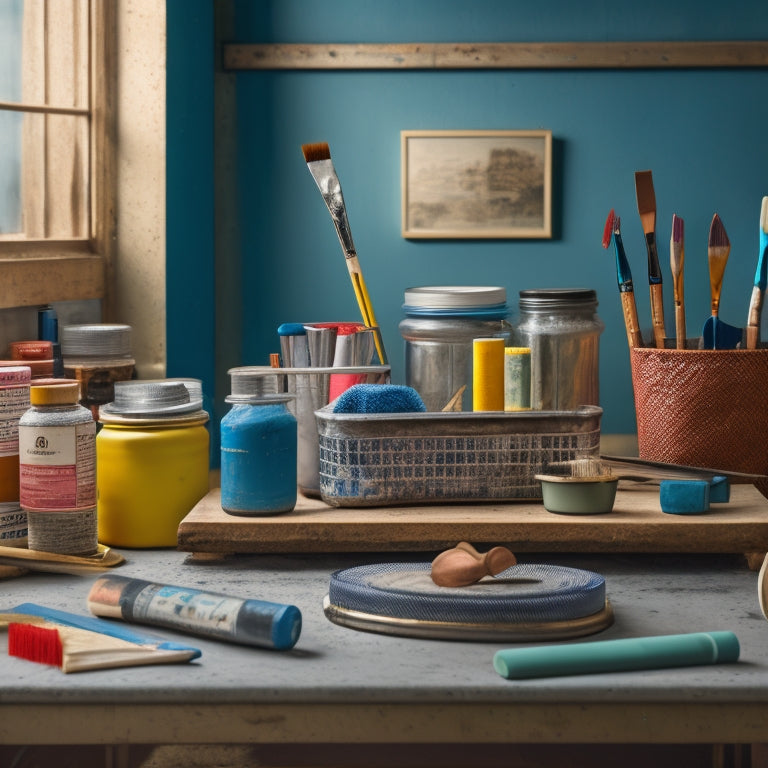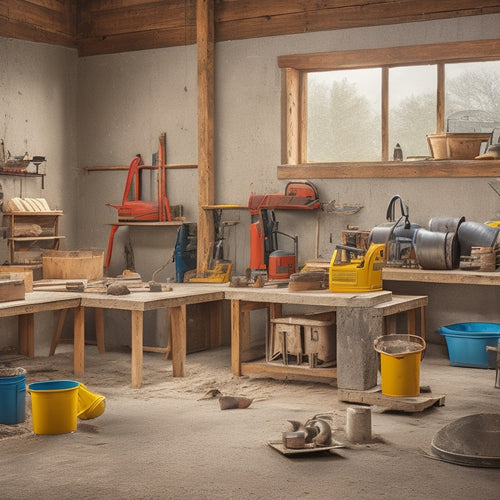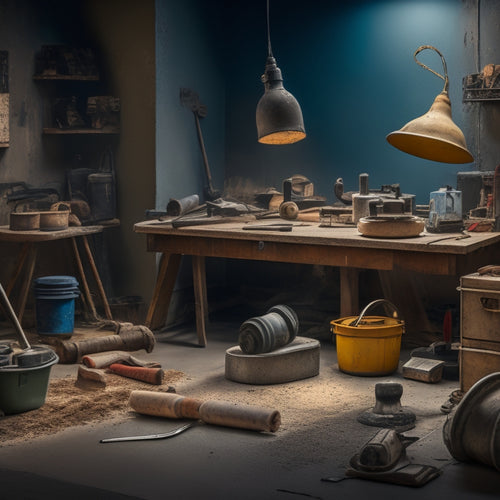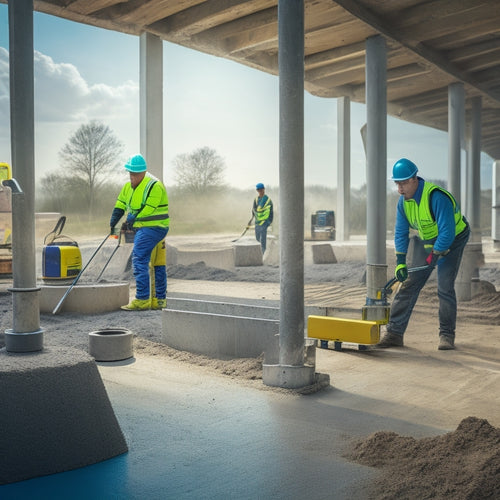
Top Tools for Painting Concrete Railings Perfectly
Share
To paint your concrete railings perfectly, you'll need to select the right paint type, prepare the surface with a wire brush or sandpaper, and apply a primer for ideal adhesion and coverage. Use sturdy paint brushes with natural bristles and flagged tips to achieve a smooth finish. A roller extension with a microfiber or woven roller and an ergonomic handle is also essential. Don't forget to invest in a high-quality paint tray and liner, as well as safety gear like goggles, a respirator mask, and gloves. With these tools and a focus on detail, you'll be well on your way to a professional-looking finish - and there's still more to explore to guarantee your project turns out exactly as you envision.
Key Takeaways
• Select the right paint type and brushes, considering factors like durability, weather resistance, and surface texture for a professional finish.
• Invest in high-quality rollers and extension poles that fit your project's needs, ensuring efficient paint application and minimizing fatigue.
• Use a suitable paint tray and liner, taking into account factors like capacity, width, and depth to prevent spills and ensure smooth application.
• Don't forget essential safety gear, including safety goggles, respirator masks, gloves, and coveralls to protect yourself from paint and chemicals.
• Utilize specialized tools like sandpaper, steel wool, and microfiber cloths to prepare and smooth the surface, ensuring a flawless finish.
Essential Painting Supplies Needed
When undertaking a concrete railing painting project, gathering essential painting supplies is critical to achieving a professional-looking finish and guaranteeing a successful outcome.
You'll need to select the right paint type for your concrete railing, considering factors like durability, weather resistance, and color retention. Acrylic, epoxy, and polyurethane-based paints are popular options, each with its unique benefits and drawbacks.
Before applying paint, thorough surface preparation is essential. Clean the railing thoroughly to remove dirt, grime, and old paint. Use a wire brush or sandpaper to roughen the surface, creating a better bond between the old surface and new paint.
If necessary, apply a primer to guarantee ideal adhesion and coverage. Don't forget to mask off surrounding areas, such as rail caps, posts, or nearby surfaces, using painter's tape or masking film.
With the right paint and surface preparation, you'll be well on your way to a beautifully painted concrete railing that will stand the test of time.
Best Paint Brushes for Concrete
With your surface preparation complete, you'll need to select the right paintbrushes to assure a smooth, even application of paint to your concrete railing.
When it comes to painting concrete, you'll want to choose brushes with sturdy bristles that can withstand the rough surface. Natural bristle brushes, such as China bristle or pure bristle, are ideal for concrete as they can absorb and hold a lot of paint. Synthetic bristles, on the other hand, may not be as effective and may leave streaks or marks.
When selecting a brush, consider the width variations to guarantee you have the right tool for the job. A 2-3 inch wide brush is perfect for cutting in around railings and posts, while a 4-6 inch wide brush is better suited for larger, flat areas.
Look for brushes with flagged or tapered bristles, which allow for a more precise application and reduce the risk of drips or runs. Additionally, choose a brush with a sturdy ferrule (the metal band that holds the bristles in place) to prevent the bristles from coming loose during use.
Choosing the Right Roller Extension
When choosing a roller extension for painting concrete railings, you'll want to evaluate the type of roller that's best suited for the job, as it can greatly impact the quality of your finish.
You'll also need to think about the length of the pole, as it affects your reach and comfort while working.
Additionally, don't overlook the ergonomics of the handle, as a comfortable grip can make all the difference in reducing fatigue and improving control.
Roller Type Matters
Selecting the right roller extension for your painting project is essential, as it directly affects the quality of the finish and the efficiency of the process. You'll want to evaluate the type of roller that will work best for your concrete railing project.
When it comes to roller materials, you'll have a few options to choose from. Here are three key considerations to keep in mind:
-
Microfiber rollers: These rollers are ideal for smooth surfaces and provide a high-quality finish. They're also lint-free, which means you won't have to worry about leaving behind fibers.
-
Woven rollers: These rollers are better suited for textured surfaces and can handle rougher concrete railings. They're also more durable than microfiber rollers.
-
Foam rollers: Foam rollers are great for rough, porous surfaces and can absorb a lot of paint. However, they may leave behind texture marks.
Pole Length Importance
You'll need to pair your chosen roller type with an extension pole of the right length to guarantee efficient and effective painting of your concrete railings. The pole length you choose will directly impact the quality of your work, as it affects your reach, comfort, and overall control.
| Pole Height | Recommended Use |
|---|---|
| 4-6 feet | Short railings, tight spaces |
| 6-8 feet | Standard railings, average height |
| 8-10 feet | Taller railings, increased reach |
| 10+ feet | Long, continuous railings, maximum reach |
When selecting a pole length, consider the height of your railings, the width of your roller, and your personal comfort level. A longer pole can provide increased reach, but may compromise pole stability. Conversely, a shorter pole may offer greater control, but limit your reach. Find the sweet spot that balances your needs for efficient painting. Remember, a sturdy and stable pole is essential for achieving a smooth, even finish. By choosing the right pole length, you'll be well on your way to painting concrete railings like a pro.
Handle Ergonomics Count
With the right pole length in hand, focus now shifts to the handle ergonomics of your roller extension, an important factor in reducing fatigue and improving overall painting performance.
As you'll be holding the extension for extended periods, it's vital to choose a handle that fits comfortably in your hand. Look for ergonomic designs that provide a comfort grip, allowing you to maintain control without straining your hand or wrist.
Here are three key considerations for handle ergonomics:
-
Contoured grip: A contoured grip will cradle your hand, reducing fatigue and providing a secure hold.
-
Handle material: Opt for handles made from materials with good grip, such as rubber or foam, to guarantee a secure hold even with gloves on.
-
Adjustable handles: Consider handles with adjustable lengths or angles to accommodate different hand sizes and painting styles.
Paint Tray and Liner Essentials
When selecting a paint tray for your concrete railing project, you'll need to take into account the size of the tray, as it directly impacts the efficiency of your painting process.
A tray that's too small will require frequent refills, wasting your time, while one that's too large can lead to paint spillage and mess.
You'll also need to choose the right liner material, as it affects paint flow and cleanup, so take the time to evaluate your options carefully.
Tray Size Matters
Nine-inch paint trays are the most popular choice for painting concrete railings, as they can hold a sufficient amount of paint and fit comfortably in most handrails. However, it's crucial to take into account the tray dimensions and how they impact paint coverage.
When selecting a paint tray, you'll want to verify it can hold enough paint to complete a section of railing without needing to be refilled too frequently.
Here are three key factors to bear in mind when choosing a paint tray:
-
Tray capacity: A larger tray may seem convenient, but it can be heavy and difficult to manage. A smaller tray may require more frequent refills, but it's often more comfortable to hold and maneuver.
-
Tray width: A wider tray can cover more surface area with each pass, but it may not fit into narrower railing sections. A narrower tray may be more versatile, but it may require more strokes to achieve the same coverage.
-
Tray depth: A deeper tray can hold more paint, but it may be more prone to drips and spills. A shallower tray may require more frequent refills, but it's often easier to manage and reduces the risk of messes.
Liner Material Options
Selecting the right liner material is crucial, as it directly impacts paint performance, adhesion, and overall finish quality on your concrete railings.
When choosing a liner, you'll want to take into account liner durability options that can withstand the rigors of painting concrete. Look for liners made from high-quality materials that are resistant to tears, punctures, and abrasion. This will guarantee a smooth, even paint application and prevent paint from seeping underneath the liner.
You should also reflect on the environmental impact of your liner material. Opt for liners made from eco-friendly materials or those that are recyclable. This not only reduces waste but also helps minimize the carbon footprint of your project.
Additionally, some liner materials may be more prone to paint absorption, which can affect the finish quality. Be sure to choose a liner that's designed to work with your specific paint type to guarantee the best results.
Safety Gear for Concrete Painting
You'll need to wear personal protective equipment (PPE) to prevent exposure to paint fumes, dust, and other hazardous materials when painting concrete railings. This is essential to ensuring your safety and health throughout the project.
Here are three essential safety gear items you shouldn't skip:
-
Safety goggles: These protect your eyes from paint splatters, dust, and other debris. Look for goggles with anti-fog lenses and a comfortable fit.
-
Respirator mask: A respirator mask filters out harmful particles and fumes, preventing respiratory issues. Choose a mask with a HEPA filter and an adjustable strap for a secure fit.
-
Gloves and coveralls: Protective gloves and coveralls prevent skin contact with paint and other chemicals. Opt for gloves with grip to prevent slipping, and coveralls with a breathable fabric.
Remember to always follow the manufacturer's instructions when using these safety gear items.
Don't take shortcuts when it comes to your safety – investing in proper PPE is essential for a successful and safe concrete railing painting project.
Measuring and Marking Tools
To guarantee accurate and precise painting, start by gathering essential measuring and marking tools that will help you achieve a professional-looking finish on your concrete railings.
You'll need a reliable tape measure to ascertain measurement accuracy, which is critical for calculating the amount of paint and materials required. A level will also come in handy to confirm your markings are straight and even.
For marking techniques, consider using a chalk line reel or a laser level to create precise lines and patterns. These tools will help you achieve crisp, clean edges and prevent errors.
Additionally, a marking gauge will allow you to make consistent, accurate measurements and markings. With these tools, you'll be able to accurately measure and mark your concrete railings, resulting in a flawless paint job.
Smoothing and Finishing Tools
With a solid foundation of measurements and markings in place, focus on gathering smoothing and finishing tools to make certain a silky, even finish on your concrete railings.
You'll want to make sure that your railings are free of imperfections, such as bumps, ridges, or rough spots, which can affect the final paint job. To achieve a flawless finish, you'll need the right tools for the job.
Here are the essential smoothing and finishing tools you'll need:
-
Sandpaper: Invest in a variety of grits, ranging from coarse to fine, to tackle different levels of roughness. Use progressively finer grits to achieve a smooth surface.
-
Steel wool: This versatile tool is perfect for removing minor imperfections and creating a smooth, even surface. Use it to wipe down the railings before painting.
-
Microfiber cloths: These soft, gentle cloths are ideal for dusting and wiping down the railings, making certain a clean surface for painting.
Frequently Asked Questions
Can I Paint Concrete Railings in Direct Sunlight?
When painting concrete railings, you should avoid direct sunlight, as it can cause uneven drying and temperature fluctuations, affecting adhesion and finish quality; instead, opt for shaded or overcast conditions to guarantee ideal results.
How Long Does Concrete Railing Paint Typically Last?
Like a well-crafted time capsule, your concrete railing paint job will last, but its longevity depends on you; with proper maintenance, it can last 5-10 years, but neglect it and it'll fade like a sunset in 2-3 years.
Do I Need to Sand the Railings Before Painting?
You'll need to sand the railings before painting to guarantee a strong bond between the concrete and paint, as sanding techniques improve paint adhesion, creating a smooth surface for a durable, long-lasting finish.
Can I Use a Power Washer to Clean the Railings?
As you're considering cleaning methods, coincidentally, using a power washer is a great option. You'll find it's an effective cleaning technique, especially for concrete railings, as it efficiently removes dirt and grime, showcasing the power washer's effectiveness in prep work.
Is Special Preparation Needed for Rusty Railings?
When dealing with rusty railings, you'll need to remove rust completely using a wire brush or sandpaper, then apply a rust-inhibiting primer to guarantee a strong bond between the metal and paint.
Conclusion
As you put the final brushstroke on your newly painted concrete railing, step back and admire your masterpiece.
The once-drab surface now radiates vibrancy, like a symphony of colors in harmony.
Your tools, now laid to rest, have conducted a flawless performance.
The paintbrushes, like gentle fingers, have danced across the surface.
The roller extension, a steady heartbeat, has maintained a consistent rhythm.
Your masterpiece is complete, a reflection of the harmony of art and precision.
Related Posts
-

What Tools to Rent for a Concrete Home Reno
When tackling a concrete home renovation, you'll need to rent a variety of specialized tools to get the job done. For...
-

Top Concrete Resurfacing Tools for a Pro Finish
When it comes to achieving a professional finish in concrete resurfacing projects, you require the right set of speci...
-

What Tools Ensure Precise Concrete Leveling Results
You need a range of specialized tools to achieve precise concrete leveling results. Laser leveling instruments provid...


